When it comes to hip replacement surgery, the femoral head of the hip prosthesis is one of the most critical components. It plays a crucial role in restoring mobility and relieving pain for patients with hip joint diseases such as osteoarthritis or avascular necrosis of the femoral head.
There are different types of hip prosthesis femoral heads for choice, each designed to meet specific patient needs and anatomical considerations. The most common materials are metal, ceramic and polyethylene.
Metal femoral head is typically made of cobalt-chromium or titanium alloys and are known for their durability and strength. They are typically used in younger, more active patients who require a robust solution that can withstand higher levels of activity.
Ceramic femoral heads, on the other hand, are favored for their low wear rate and biocompatibility. They are less likely to cause allergic reactions, making them an ideal choice for patients with metal sensitivities. Furthermore, ceramic femoral heads offer a smoother joint surface, reducing friction and wear.
Polyethylene femoral heads are typically used in conjunction with metal or ceramic components. They are designed to provide cushioning and are generally more cost-effective. However, compared to metal or ceramic components, they may wear out faster, making them less suitable for younger and more active patients.
In summary, the choice of hip joint prosthesis femoral head is crucial to the success of hip replacement surgery. Understanding the various types of femoral heads—metal, ceramic, polyethylene, and hybrid—can help patients and healthcare providers make informed decisions based on their individual needs and lifestyles.
Post time: Aug-12-2025

